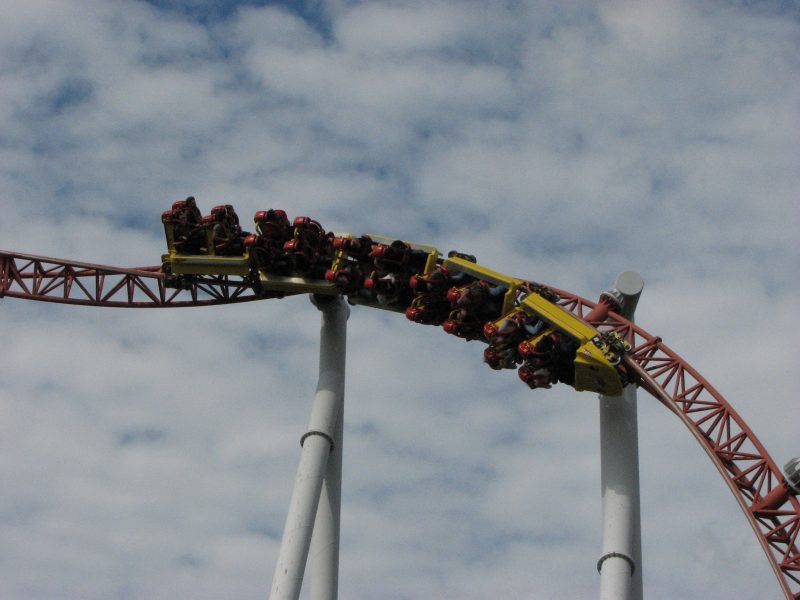The Kinetic energy It is the one that a body acquires due to its movement and that is defined as the amount of work necessary to accelerate a body at rest and of a given mass to a set speed. For instance: a man on a skateboard, a thrown ball, a roller coaster cart.
This energy is acquired through a acceleration, after which the object will keep it the same until the speed varies (accelerate or slow down) so that, to stop, it will require negative work of the same magnitude as its accumulated kinetic energy. Thus, the longer the time in which the initial force acts on the moving body, the greater the speed reached and the greater the kinetic energy obtained.
Difference between kinetic energy and potential energy
The kinetic energy, together with the potential energy, add up the total mechanical energy (Em = Ec + Ep). These two forms of mechanical energy, kinetic and potential, are distinguished in that the latter is the amount of energy associated with the position that an object occupies at rest and can be of three types:
- Gravitational potential energy. It depends on the height at which the objects are placed and the attraction that gravity would exert on them.
- Elastic potential energy. It is the one that occurs when an elastic object recovers its original shape, like a spring when it is decompressed.
- Electric potential energy. It is the one contained in the work carried out by a specific electric field, when an electric charge inside it moves from a point in the field to infinity.
Kinetic energy calculation formula
Kinetic energy is represented by the symbol Ec (sometimes also E– or E+ or even T or K) and its classic calculation formula is ANDc = ½. m. v2 where m represents mass (in Kg) and v represents velocity (in m / s). The unit of measurement for kinetic energy is Joules (J): 1 J = 1 kg. m2/ s2.
Given a Cartesian coordinate system, the kinetic energy calculation formula will have the following form: ANDc= ½. m (ẋ2 + ẏ2 + ¿2)
These formulations vary in relativistic mechanics and quantum mechanics.
Kinetic energy exercises
- An 860kg car travels at 50 km / h. What will its kinetic energy be?
First we transform the 50 km / h to h / s = 13.9 m / s and we apply the calculation formula:
ANDc = ½. 860 kg. (13.9 m / s)2 = 83,000 J.
- A stone with a mass of 1500 Kg rolls down a slope with accumulating a kinetic energy of 675000 J. At what speed is the stone moving?
Since Ec = ½. m .v2 we have 675000 J = ½. 1500 Kg. v2,
and when solving the unknown, we have to v2 = 675000 J. 2/1500 Kg. 1, whence v2 = 1350000 J / 1500 Kg = 900 m / s,
and finally: v = 30 m / s after solving the square root of 900.
Examples of kinetic energy

- A man on a skateboard. A skateboarder on the concrete U experiences both potential energy (when it stops at its ends for an instant) and kinetic energy (when it resumes the downward and upward motion). A skateboarder with greater body mass will acquire greater kinetic energy, but also one whose skateboard allows him to go at higher speeds.
- A porcelain vase that falls. As gravity acts on the accidentally tripped porcelain vase, kinetic energy builds up in your body as it descends and is released as it smashes against the ground. The initial work produced by the stumble accelerates the body breaking its state of equilibrium and the rest is done by the gravity of the Earth.
- A thrown ball. By printing our force on a ball at rest, we accelerate it enough so that it travels the distance between us and a playmate, thus giving it a kinetic energy that then, when tackling it, our partner must counteract with a work of equal or greater magnitude. and thus stop the movement. If the ball is bigger it will take more work to stop it than if it is small.
- A stone on a hillside. Suppose we push a stone up a hillside. The work we do when pushing it must be greater than the potential energy of the stone and the attraction of gravity on its mass, otherwise we will not be able to move it up or, worse still, it will crush us. If, like Sisyphus, the stone goes down the opposite slope to the other side, it will release its potential energy into kinetic energy as it falls downhill. This kinetic energy will depend on the mass of the stone and the speed it acquires in its fall.
- A roller coaster cart It acquires kinetic energy as it falls and increases its speed. Moments before it begins its descent, the cart will have potential and not kinetic energy; but once the movement is started, all the potential energy becomes kinetic and reaches its maximum point as soon as the fall ends and the new ascent begins. Incidentally, this energy will be greater if the cart is full of people than if it is empty (it will have greater mass).

Other types of energy
| Potential energy | Mechanical energy | Kinetic energy |
| Hydroelectric power | Internal energy | Caloric energy |
| Electric power | Thermal energy | Geothermal energy |
| Chemical energy | Solar energy | Sound energy |
| Wind power | Nuclear energy | Hydraulic energy |
